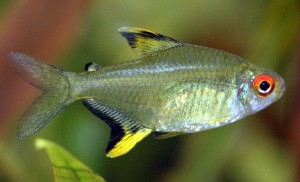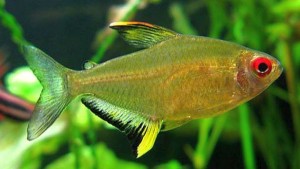The Lemon Tetra (Hyphessobrycon pulchripinnis) is an Amazon River species that was first collected from the Rio Tapajos Basin, near Santarém, Brazil. It is found in both the Rio Tapajos and stretches of the Amazon River where they join together at Santarem.
Lemon Tetras are one of the deeper bodied tetras that have a “diamond” like body shape. The body of the fish is a translucent yellow that sometimes appears to be pearlescent.
An iridescent stripe extends laterally from the gill to the start of the Caudal fin. The dorsal fin is black with a yellow central patch and the anal fin appears glass like with a black outer margin. The anterior three or four anal rays are an intense, acrylic lemon yellow, hence their common name.
The caudal fin is mostly hyaline except for the males which acquire a gunmetal blue sheen. The pectoral fins are glass like in appearance, while the pelvic fins are a translucent yellow, which in male specimens becomes more opaque yellow with black edges on the posterior. Lemon tetras possesses an adipose fin that in males may acquire a black border.
The eyes of the Lemon Tetra are a distinguishing feature of the fish. The upper half of the iris is an intense ruby red when the fish is in good condition. When the red color fades or disappears entirely, it is an indication that the fish is seriously diseased.
The only reliable method to determine the gender of this species in adult specimens is by examining the black outer border of the anal fin. In female specimens, the border looks like it was drawn onto the fin with a fine line pencil. In males, particularly alpha males, the border is conspicuously wider. During breeding, females are also more fully bodied when viewed from above.
In their natural habitat, Lemon Tetras congregate and travel in large shoals in clear, shallow, slightly acidic waters with a modest to moderate current flow, usually around submerged aquatic vegetation.
Lemon tetra shoals are often comprised of several thousand individuals that from a predatory standpoint makes predation of individual specimens extremely disruptive. When threatened, the fish weave in and out between each other at great speed, creating a vivid black and yellow wave movement that confuses predators.
Lemon Tetras are a hardy, shy, peaceful species that do best in a densely planted tank with at least 10 to 15 or more of their own kind. They mix well with other tetra species, small danios, barbs, rasboras, dwarf cichlids, Corydoras and Otocinclus catfish.
Their tank should have a fine gravel substrate, several dense thickets of plants, some driftwood roots, and plenty of swimming areas for the fish to move around in and display their best colors. Good filtration and well oxygenated water is necessary for these fish, so a power head or canister filter is recommended.
Lemon Tetras are relatively easy to breed in an aquarium environment but they are notorious for eating their eggs. The egg eating is instinctive. In the wild, tens of thousands of pairs spawn simultaneously and in order to reduce competition for their own offspring, a pair will turn around and eat some of the eggs being produced by neighboring spawning pairs. Unfortunately, this trait carries on to captive specimens.
If you place several females with one male in a well planted tank, there is an excellent possibility spawning will take place the next morning. The morning sunlight seems to stimulate spawning behavior and a single adult female in prime condition will produce as many as 300 eggs during a single spawn.
Females will release their eggs among fine leaved plants like E. Tenellus, Cabomba, or Java Moss but will promptly eat them if they are not removed from the tank. The eggs are non-adhesive and will fall through the foliage to rest at the base of the plants or on the substrate. You can preserve more eggs if you line the bottom of the breeding tank with marbles or a mesh small enough to prevent the parents from getting to the eggs.
The eggs will hatch out in approximately 72 hours at 82 °F. The fry will absorb their yolk sacs and be free swimming in another 24 to 48 hours. The fry should be fed infusoria or a special egglayer fry food for the next week or until they are able to accept newly hatched baby brine shrimp. At 12 weeks the fry become miniature versions of adults and at 9 months are sexually mature.
Lemon Tetras are easy to feed and will readily accept almost any quality flake food. They should also be occasionally offered live foods such as Daphnia, brine shrimp, or mosquito larvae. They are especially fond of live, frozen, or freeze dried bloodworms
and tubifex.
Lemon Tetras are usually available to tropical fish keeping enthusiasts when they are 3/4″ to 1 1/2″ in size.
Minimum Tank Size: 30 gallons
Care Level: Easy
Temperament: Peaceful
Water Conditions: 72-82°F, dH 3-25, pH 6.0-7.5
Max. Size: 1 1/2″
Color Form: Yellow
Diet: Omnivore
Compatibility: Peaceful
Origin: Rio Tapajos, Brazil
Family: Characidae
Life Span: 6-8 years
Aquarist Level: Beginner



